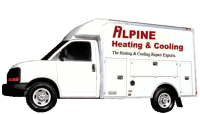Summertime in the Skagit Valley
Life doesn’t get much better than this. There is so much to do here in the summer, like the Skagit County Fair in August. The temperatures and humidity are usually in the comfort range. For the times they aren’t, many of us have air conditioning to turn to. With so much to do in the summer, and no cold days or nights, it’s easy to forget about furnace maintenance. Remember, though, the fall and winter will come…
At the time of this writing, late July, it’s as hot as it gets here in the Skagit Valley of Western Washington state. Those of us with air conditioning are probably enjoying it for at least a couple hours most days. If you haven’t had an HVAC professional out since last fall, this is a good time. One service visit can cover both air conditioning and heating maintenance. Therefore, a summer furnace maintenance from Alpine Heating and Cooling can stretch your HVAC maintenance dollar.
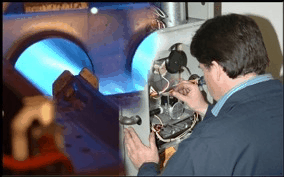
While it may seem silly to have your furnace maintenance done in the summer, there are several compelling reasons. While we’re there, we can make sure your AC is running at top efficiency, saving you money all summer, and Alpine also has the most flexible scheduling right now.
Don’t wait to schedule furnace maintenance until everyone cranks up their heating system at once in the fall. You might find yourself in a long waiting line to get a technician out to your house.
What Does a Summer Furnace Maintenance Include?
For a comprehensive, point-by-point list of what we do when we perform a furnace maintenance, please refer to our Annual Service page. For a more general overview, please read on. When it’s running smoothly, it might seem like there’s not much going on in your heating system; However, today’s carefully engineered HVAC systems allow numerous adjustments that can improve efficiency, function, and safety. Filters, safety equipment, feedback systems, and more can all be checked and brought into spec.
Visual Inspection of the HVAC System
First, we’ll check over the unit for broken, missing, or incorrect parts, substandard installation, obvious leaks, and code and safety issues. It is astonishing, the number of HVAC systems we see that include massive efficiency and safety problems (often easy to resolve) resulting from poor quality installations. Consequently, we always recommend checking the basics first.
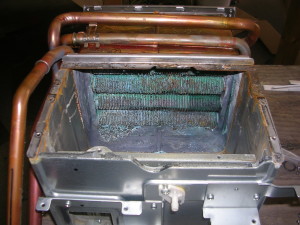
It’s a Good Idea to have a Look Inside your HVAC Unit Regularly!
Clean the HVAC Unit and Change the Filter(s)
Moving from winter into summer is an important time to check the cleanliness of your HVAC unit. After a long winter of closed windows, elevated indoor humidity, and poor ventilation and indoor air quality, your system’s controls, filter(s), and ducting can be layered with dust and debris. Dust buildup on electronic components can cause overheating and premature failure. Plugged filters overwork fans and significantly reduce air movement while providing a breeding ground for bacteria and mold.
Depending on your filter’s MERV rating, filters should be changed not less than every six months. A clean furnace filter is inexpensive insurance against poor performance, premature failure, and poor air quality in your home.
Electrical Checks
Checking the safety and integrity of the electrical supply to and throughout your HVAC unit is important. If the supply is inadequate or if safety cutoff equipment, like breakers and fuses, is missing or improperly sized, damage to your HVAC system or even catastrophic failure resulting in fire is possible. Rather than wonder, it’s best to know.
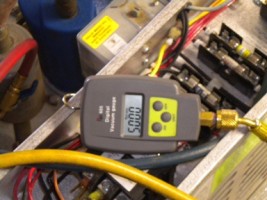
Summer Is a Great Time to Upgrade Your Furnace
If you’ve been considering upgrading to a more efficient unit, summertime is ideal. The leaps in efficiency and reliability in recent years are incredible. You won’t have to shiver through even one cold night without heat, and you avoid the inconvenience and expense of a system failure in winter.
If your system is old and inefficient, call for a free estimate to replace it. We can even estimate the payback time based on the fuel savings you’re going to enjoy.
DIY or Call a Professional?
As homeowners, it’s important to many of us to maintain a level of self-reliance. Changing the filter in your HVAC system or installing a carbon monoxide detector are good for homeowners. Turning off the pilot light in your furnace for the summer is useful and safe. We all need to know our limits, so when one of Alpine’s service trucks needs maintenance, we’re not pulling out the furnace tools to give it a shot. So, we head to a professional mechanic!
Not everyone is or even can be an expert on how to maintain their HVAC system. If you are unsure if your system is in good condition or you aren’t trained, call a professional. Alpine Heating and Cooling is fully licensed, insured, and bonded. We have years of experience to keep your HVAC system running right, and we want customers for life. We will work hard to earn your trust.
Call Alpine Heating and Cooling in Burlington, Washington at 360-755-5146 360-293-6210 for a free consultation over the phone or to schedule a furnace maintenance, HVAC repair, or upgrade. We can’t wait to help you!
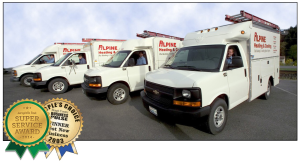
When You See This, You’re In Good Hands

As the temperature begins to drop, preparing your home for winter becomes essential to ensure warmth, comfort, and energy efficiency throughout the season. Winterizing your home not only helps keep your family cozy but also reduces energy costs and minimizes the risk of unexpected HVAC issues. Taking a few proactive steps can make all the difference in maintaining a comfortable indoor environment.
The first step in winterizing your home is ensuring that your HVAC system is in peak condition. Scheduling a professional inspection is crucial to identify and address any potential issues before the system is under constant demand. Replacing air filters is another vital task; clean filters allow for optimal airflow and prevent your heating system from overworking. For maximum efficiency, consider upgrading to a programmable or smart thermostat, which can help regulate temperatures and save on energy costs.
Sealing air leaks around your home is another important aspect of winter preparation. Drafts around windows, doors, and other openings can allow warm air to escape, making your HVAC system work harder. Applying weatherstripping, caulking gaps, and inspecting areas like attics and basements for insulation needs can significantly improve your home’s energy efficiency. Additionally, leaky ductwork can reduce heating effectiveness, so it’s wise to have it professionally sealed if needed.
Don’t overlook the importance of proper insulation throughout your home. Adding insulation to attics, walls, and crawl spaces can prevent heat loss and keep your home consistently warm. Protecting your pipes with insulation sleeves also prevents freezing and potential bursts during extreme cold.
Lastly, remember to care for your outdoor HVAC components by clearing debris, inspecting for damage, and protecting them with covers designed to withstand winter weather. By taking these steps, you can enjoy a warm, energy-efficient home all winter long.

As the leaves change color and temperatures drop, preparing your home and HVAC systems for the fall season becomes essential. Taking some time now to ensure everything is in order can help you stay comfortable, save money, and avoid potential problems when the chill of winter arrives. Here’s a comprehensive guide to help you get your home and HVAC systems ready for fall.
1. Inspect and Service Your HVAC System
Your heating, ventilation, and air conditioning (HVAC) system works hard to maintain a comfortable temperature year-round, so it’s important to give it some attention before fall sets in.
- Schedule a Professional Inspection: Have an HVAC technician conduct a thorough inspection. They will check for any issues, clean the components, and ensure your system runs efficiently. An inspection can identify problems early, potentially saving you from costly repairs during the colder months.
- Replace Air Filters: Dirty air filters can reduce the efficiency of your HVAC system and lower air quality in your home. Replace your air filters at the start of fall and check them monthly. This simple task can improve airflow, maintain system efficiency, and help keep your energy bills in check.
- Test Your Thermostat: Ensure your thermostat is functioning correctly and consider upgrading to a programmable or smart thermostat. This allows you to set schedules, control temperatures remotely, and reduce energy consumption when you’re not home, optimizing your heating system’s efficiency.
2. Seal and Insulate Your Home
A properly sealed and insulated home can make a big difference in energy efficiency and comfort levels.
- Check for Drafts: Inspect windows, doors, and any other openings for drafts. Use weatherstripping and caulk to seal any gaps or cracks. This prevents warm air from escaping and cold air from entering, helping your HVAC system work more efficiently.
- Inspect Insulation: Ensure your home’s insulation is adequate, especially in the attic, basement, and crawl spaces. Proper insulation helps maintain a consistent temperature, reducing the strain on your HVAC system and lowering energy bills.
3. Clean and Inspect Ductwork
Dirty or leaky ductwork can significantly affect the performance of your HVAC system.
- Inspect Ductwork for Leaks: Check for any visible signs of leaks or damage in your ductwork. Sealing any leaks with duct tape or mastic can improve airflow and reduce energy loss.
- Clean the Ducts: Over time, dust, debris, and allergens accumulate in your ducts. Consider having your ductwork professionally cleaned to ensure good air quality and efficient system performance.
4. Prepare Your Furnace
Before the colder months arrive, your furnace needs to be in peak condition.
- Check the Furnace Flame: Ensure the flame in your furnace is blue, indicating it’s burning efficiently. If the flame is yellow or orange, it may indicate a problem, such as a gas leak or dirty burner, requiring professional attention.
- Clear the Area Around the Furnace: Remove any clutter, dust, or flammable materials around your furnace to ensure proper airflow and reduce the risk of fire.
5. Inspect and Clean Your Chimney and Fireplace
If you have a chimney or fireplace, regular maintenance is crucial for safety and efficiency.
- Schedule a Chimney Inspection and Cleaning: A professional chimney sweep can remove soot, creosote, and any obstructions that could cause a fire hazard. Regular cleaning also ensures proper ventilation when using your fireplace.
- Check the Damper: Make sure your fireplace damper opens and closes properly to prevent drafts and maintain energy efficiency.
6. Maintain Your Outdoor Unit
If you have an outdoor HVAC unit, it’s essential to prepare it for the fall season.
- Clear Debris: Remove leaves, twigs, and any debris around your outdoor unit. This helps ensure proper airflow and prevents damage to the system.
- Check the Unit for Damage: Inspect your outdoor unit for any signs of wear and tear, such as rust, cracks, or loose connections. Addressing these issues promptly can prevent further damage.
7. Reverse Ceiling Fans
Ceiling fans aren’t just for summer—they can help keep your home comfortable in the fall and winter, too.
- Reverse the Fan Direction: Most ceiling fans have a switch to change the direction of the blades. In the fall, set your fan to rotate clockwise at a low speed. This creates an updraft, pulling cool air up and pushing warm air down, which helps distribute heat more evenly throughout your home.
8. Inspect Weatherstripping and Door Seals
Keeping cold air out is just as important as keeping warm air in.
- Check Weatherstripping: Inspect and replace any worn or damaged weatherstripping around doors and windows to prevent drafts and heat loss.
- Install Door Sweeps: If you notice drafts under doors, consider installing door sweeps to block out cold air.
9. Check Smoke and Carbon Monoxide Detectors
Safety is paramount, especially when you’ll be using your heating system more frequently.
- Test Detectors: Make sure smoke and carbon monoxide detectors are working correctly. Replace batteries and test each unit to ensure they are functioning properly. Consider installing new detectors if yours are more than 10 years old.
10. Clean Gutters and Downspouts
Fall is known for its beautiful leaves, but those leaves can clog your gutters and downspouts.
- Clear Gutters: Remove leaves, twigs, and debris from your gutters and downspouts to prevent water damage to your roof, siding, and foundation. Proper drainage is essential to avoid leaks and ice dams during winter.
Getting your home and HVAC systems ready for fall is an investment in comfort, safety, and energy savings. By following these steps, you’ll be well-prepared for the colder months ahead, ensuring a cozy and efficient home all season long. Take the time now to inspect, clean, and maintain your home and HVAC systems to enjoy a worry-free fall and winter.
Remember, a little preparation goes a long way! Happy fall! 🍂
As the cold of winter fades away and the warmth of spring emerges, it’s easy to get caught up in the Daffodil and Tulip Festivals: longer days, blooming flowers, and the promise of summer adventures. However, amidst the excitement, there’s an essential task that often goes overlooked but shouldn’t be ignored: servicing your HVAC (Heating, Ventilation, and Air Conditioning) systems.
Spring is the perfect time to ensure that your HVAC systems are in optimal condition. While it might seem like an unnecessary chore, regular maintenance can save you from unexpected breakdowns, costly repairs, and even potential health hazards. Let’s delve into why servicing your HVAC systems in the spring is crucial.
- Efficiency Boost: After working hard to keep you warm throughout the winter months, your HVAC system may have accumulated dust, debris, and worn-out components. A spring servicing can address these issues, ensuring that your system operates at maximum efficiency. By cleaning filters, coils, and ducts, your HVAC technician can help your system run smoothly, which ultimately translates to lower energy bills and reduced environmental impact.
- Preventing Breakdowns: Imagine the discomfort of a warm day, only to find that your air conditioning system has stopped working. HVAC breakdowns often occur when systems are pushed to their limits during the hottest days of summer. By servicing your HVAC system in the spring, you can identify and address potential problems before they escalate into major issues. This proactive approach not only saves you from the inconvenience of a malfunctioning system but also prevents emergency repair costs and downtime when you need your HVAC the most.
- Improved Indoor Air Quality: Your HVAC system plays a crucial role in maintaining indoor air quality by circulating and filtering the air you breathe. Over time, dust, allergens, and pollutants can accumulate within the system, leading to poor air quality and potential health problems. Spring servicing involves cleaning and replacing filters, removing debris, and inspecting ductwork to ensure that your indoor air remains clean and healthy. This is particularly important for individuals with allergies, asthma, or respiratory conditions, as well as for creating a comfortable living environment for everyone in your home.
- Prolonged Lifespan: Like any mechanical system, regular maintenance can extend the lifespan of your HVAC equipment. By addressing minor issues early on and performing routine tune-ups, you can prevent premature wear and tear, corrosion, and other damage that could shorten the lifespan of your system. Investing in spring servicing not only protects your HVAC system but also safeguards your investment in home comfort for years to come.
- Peace of Mind: Finally, scheduling spring servicing for your HVAC system provides peace of mind knowing that your home’s heating and cooling needs are taken care of. With regular maintenance, you can rest assured that your system is operating efficiently, safely, and reliably, regardless of the weather outside. Whether it’s a sudden heatwave or an unexpected cold snap, you can trust that your HVAC system is up to the task.
Spring HVAC servicing is not just another item on your to-do list—it’s a critical aspect of home maintenance that shouldn’t be overlooked. By investing in routine maintenance, you can enjoy improved efficiency, reliability, and indoor air quality while extending the lifespan of your HVAC system. So, before you get swept up in the excitement of spring, take the time to schedule a professional servicing for your HVAC system. Your future self will thank you for it.

As the leaves turn golden and the air grows crisper in Skagit Valley, there’s nothing quite like the feeling of coziness that autumn brings. While you may be busy decorating your home, sipping on pumpkin spice lattes, and planning your next hayride in the Valley, it’s crucial not to forget about your HVAC system. As temperatures start to drop, ensuring your heating system is in top-notch condition with expert HVAC technicians becomes paramount.
Preparing for the Chill
Fall is the perfect time to give your HVAC system the attention it deserves. Our expert technicians are equipped to perform comprehensive maintenance checks, ensuring your system runs efficiently and effectively. From inspecting the ductwork to cleaning or replacing air filters, we leave no stone unturned.

Maximizing Energy Efficiency
As the days get shorter and the nights longer, your HVAC system will work overtime to keep you comfortable. Our professional services can help optimize your system’s energy efficiency, saving you money on your energy bills while reducing your environmental footprint.
Furnace Installation and Upgrades
If your existing furnace shows signs of wear and tear, it might be time for an upgrade. Our seasoned technicians can guide you through selecting a new, energy-efficient furnace that suits your comfort needs and budget.
Safety First
With the onset of cooler weather, ensuring that your heating system is safe to use is crucial. Our technicians are trained to detect and address potential safety hazards, such as gas leaks or faulty electrical connections, providing you with peace of mind.
Smart Thermostat Installation
Embrace the latest technology this fall by installing a smart thermostat. These innovative devices allow you to remotely control your home’s temperature, ensuring you return to a warm and inviting environment, even on the chilliest of evenings.
At Alpine Heating and Cooling, our expert HVAC team is dedicated to keeping your home cozy and comfortable throughout the fall season. Our experienced technicians are here to provide you with top-tier HVAC services, from routine maintenance to full system installations. Don’t wait until the cold weather sets in – schedule your appointment today with our expert HVAC team and let us help you make this fall your coziest yet!

As the vibrant colors of summer begin to fade, it’s time to transition your home to embrace the coziness and warmth of fall. By taking some proactive steps now, you can ensure your space is not only comfortable but also ready to face the colder months ahead. Make your home maintenance fall checklist, and contact us to help with servicing your heating system!
Inspect and Clean Gutters
Fallen leaves and debris can quickly clog up your gutters, potentially leading to water damage and leaks. Make sure to clean them out and ensure they’re in good condition before the rainy season arrives.
Check for Drafts
Inspect windows and doors for any gaps or cracks that may allow cold air to seep in. Seal these areas with weatherstripping or caulk to keep your home warm and energy-efficient.
Service Your Heating System
Before the temperatures drop significantly, have a professional service your heating system. This ensures it’s running efficiently and reduces the risk of any unexpected breakdowns during the colder months.
Clean and Inspect Your Fireplace or Heating Appliance
If you have a fireplace, wood stove, or any other heating appliance, ensure it’s clean and in good working order. Have the chimney inspected and cleaned to prevent potential fire hazards.
Test Smoke and Carbon Monoxide Detectors
Fall is a great time to check the batteries in your smoke and carbon monoxide detectors. Replace them if needed and ensure these life-saving devices are in working condition.
Switch to Heavy-Duty Bedding
Swap out lightweight summer bedding for warmer, cozier options. Consider adding extra blankets or a duvet to your bed for extra warmth during chilly nights.
Insulate Pipes
Prevent frozen pipes by insulating them in areas that are susceptible to cold, such as basements, attics, and crawl spaces. This simple step can save you from a major headache later on.
Clean and Store Outdoor Furniture
Protect your outdoor furniture from the elements by cleaning it thoroughly and storing it in a sheltered area, like a garage or shed. If you don’t have space, invest in high-quality covers.
Fertilize Your Lawn and Garden
Autumn is an important time to nourish your lawn and garden for healthy growth in the spring. Apply a balanced fertilizer to promote root development and prepare plants for the winter months.
Decorate for Fall
Embrace the spirit of the season by adding fall-themed decor to your home. Consider incorporating warm colors, cozy textiles, and seasonal accents like pumpkins, gourds, and wreaths.
By following this fall home maintenance checklist, you’ll create a cozy and inviting atmosphere in your home and ensure it’s well-prepared to face the challenges that fall may bring. Taking these proactive steps now will help you enjoy the beauty of autumn without any unexpected surprises. Happy fall decorating!

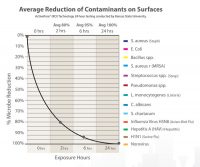
While our attention is focused on the spread of Coronavirus, and we are thinking about the necessary precautions that are needed to reduce our chances of coming in contact with this virus, HVAC professionals know that Coronavirus is not the only disease, germ, virus, or pollutant we need to combat in our homes. We also need to consider the other viruses and germs that are spread through a central HVAC system. People spend about 90% of their lives indoors, and pollutant levels can be as high as 100 times the levels encountered  outside. The Environmental Protection Agency (EPA) ranks indoor air pollution among the top four environmental hazards in America. One-way people can be proactive and protect themselves from getting sick in general is by being educated on Indoor Air Quality (IAQ).
outside. The Environmental Protection Agency (EPA) ranks indoor air pollution among the top four environmental hazards in America. One-way people can be proactive and protect themselves from getting sick in general is by being educated on Indoor Air Quality (IAQ).
There are four particular groups (although all people could benefit) that need the best possible air quality in the home:
- Infants to 16-years-old
- Adults, age 60 plus
- No age restriction – immune-compromised individuals, pregnant women, and persons with chronic respiratory disorders, and those recovering from surgical procedures or illness
- Pet owners with domestic animals – dogs, cats, and birds
Scientist believes the principal transmission mode of the Coronavirus is by respiratory droplets, which may travel several  feet from someone who is coughing or sneezing. Covering your mouth when you cough or sneeze is the first step to control the spread. However, residual contaminants can travel through your HVAC system, where all air in the home is circulated and can contribute to the spread of an airborne virus. The Coronavirus has the same traits as other viruses such as the common cold, the flu, and a sore throat, by how it is spread from person-to-person.
feet from someone who is coughing or sneezing. Covering your mouth when you cough or sneeze is the first step to control the spread. However, residual contaminants can travel through your HVAC system, where all air in the home is circulated and can contribute to the spread of an airborne virus. The Coronavirus has the same traits as other viruses such as the common cold, the flu, and a sore throat, by how it is spread from person-to-person.
Source control is always the first step when dealing with IAQ concerns such as mold, dust, odor, and even viruses. There are many remedies when it comes to managing IAQ in a home. Some products range from a higher Minimum Efficiency Reporting Value (MERV) rated filter, electronic air cleaners, and ultra-violet sterilization systems. The HVAC system and duct system can contribute to spreading unwanted pathogens in the air, not because your system came contaminated from the factory, but because the air in your home became contaminated.
Tiny pathogens spread in the air can be fungi, bacteria, or viruses. The difference between a virus and bacteria is viruses are much smaller than bacteria, and viruses cannot survive without a host. According to the Mayo Clinic, fewer than 1% of bacteria cause disease in people.
In addition to spreading viruses through an HVAC system, another nemesis is mold, a biological growth. Mold is, in the  simplest terms, part of the “dust to dust” program. Everything living will die, it will return to the food chain, whether it’s a mighty oak tree, your favorite leather shoes (once upon a time, a cow), or that forgotten orange in the back of the refrigerator.
simplest terms, part of the “dust to dust” program. Everything living will die, it will return to the food chain, whether it’s a mighty oak tree, your favorite leather shoes (once upon a time, a cow), or that forgotten orange in the back of the refrigerator.
Your HVAC system can provide biological growth the perfect opportunity to form and grow. There are three things needed to support biological growth. Food is the number one source of supporting biological growth. One example of food sources is skin cells that have flaked off and floated into the HVAC system. The next item to support organic growth is moisture. Once those skin cells made it through the system, they can become attached to the evaporator coil or blower motor. When the coil starts to produce condensation along with the food source, it becomes the perfect recipe for biological growth. The final item to contribute to organic growth is the absence of ultraviolet light. HVAC professionals and homeowners who manage these factors, reduce the risk of biological growth.
To set the record straight:
- Mold and viruses are not a factory option
- AC units do not create mold or viruses
- If you have mold or viruses, it is your mold and viruses
- An ultra-violet system will not keep your home mold or virus-free
When an ultra-violet system is used correctly and installed to the manufacture’s guidelines, it can prove to be a useful tool. Ultra-violet exists in natural sunlight (it’s why we wear sunscreen, and mold grows under a rock), it disassembles the DNA of organics. It reduces them to nitrogen and oxygen. Ultra-violet is most effective as surface irradiation (with a limited “kill zone”) and is used in many applications. It is used to sterilize medical instruments, clean reclaimed water in treatment plants, saltwater aquariums, and is used in food processing.
Contractors should educate customers on the value of IAQ and provide solutions and options to help the homeowner make educated decisions. An HVAC system should be inspected at a minimum, twice a year. Visit The National Air Duct Cleaners Association for recommendations on HVAC system cleaning. Be sure to ask your HVAC technician on products that can help you breath cleaner, fresher, healthier air.
In times like these, when emotions run high, and everyone is concerned about the unknown, HVAC professionals need to shine as a beacon of truth and good faith. Quality maintenance, good hygiene, and proven best practices such as; improved indoor air quality, source control for contamination, and keeping a clean house are the keys to successfully navigating current health issues.
By: Matt Akins, ACCA Manager of HVACR Education
ACCA is a non-profit association serving more than 60,000 professionals and 4,000 businesses in the indoor environment and energy services community. Our member firms are the nation’s most professional contracting businesses, serving residential and commercial customers in every state. With roots stretching back a century, ACCA was incorporated in its present form nearly 50 years ago. Today, ACCA sets the standards for quality comfort systems, provides leading-edge education for contractors and their employees, and fights for the interests of professional contractors throughout the nation. Learn more about ACCA here.
Reference Sources
https://www.epa.gov/report-environment/indoor-air-quality
https://www.cdc.gov/mmwr/volumes/69/wr/mm6908e1.htm

Dirt and neglect are the top causes of heating and cooling system inefficiency and failure in Skagit Valley. To ensure an efficient system
operation, it’s essential to maintain your HVAC system.
Change your air filter regularly. A clean filter will prevent dust and dirt from building up in the system, which can lead to expensive maintenance and early system failure. Check your filter every month, especially during winter and summer months, when use tends to be heavier. Change your filter if it’s dirty—or at least every three months to maintain your HVAC system properly.
Tune up your HVAC equipment. Proper maintenance by an Alpine Heating and Cooling qualified technician is one of the most important steps you can take to prevent future problems. We get busy during the summer and winter months, so it is best to check the cooling system in spring and the heating system in the fall. Plan the checkups around the beginning and end of daylight-saving time each spring and fall.
Overall HVAC System Maintenance Checklist
- Check thermostat settings to ensure the heating and cooling system turns
on and off at the programmed temperatures. - Tighten all electrical connections and measure voltage and current on
motors. Faulty electrical connections can cause your system to operate
unsafely and reduce the life of major components. - Lubricate moving parts. Parts that lack lubrication cause friction in motors
and increase the amount of electricity you use. Lack of lubrication can also
cause equipment to wear out more quickly, requiring more frequent repairs
or replacements. - Check and inspect the condensate drain in your central air conditioner,
furnace, and heat pump (when in cooling mode). If plugged, the drain
can cause water damage in the house, affect indoor humidity levels, and
breed bacteria and mold. - Check system controls to ensure proper and safe operation. Check the starting
cycle of the equipment to assure the system starts, operates, and shuts
off properly. - Inspect, clean, or change the air filter in your central air conditioner, furnace,
and heat pump. Your contractor can show you how to do this yourself.
Depending on your system, your filter may be located in the duct system versus
the heating and cooling equipment itself.
Additional HVAC System-Specific Maintenance Activities
For Heating Systems:
- Inspect the flue piping for rusting and any disconnections or evidence of
back drafting. - Check all gas (or oil) connections, gas pressure, burner combustion, and heat
exchanger. Improper burner operation can be caused by a dirty burner or a
cracked heat exchanger—either can cause the equipment to operate less safely
and efficiently. Leaking gas (or oil) connections are also a fire hazard and can
contribute to health problems.
For Cooling Systems:
- Clean indoor and outdoor coils before warm weather starts. A dirty coil
reduces the system’s ability to cool your home and causes the system to run
longer, increasing your energy costs and shortening the life of your equipment. - Check your central air conditioner’s refrigerant charge and adjust it if
necessary to make sure it meets manufacturer specifications. Too much or too
little refrigerant charge can damage the compressor, reducing the life of your
equipment and increasing costs. - Clean and adjust blower components to provide proper system airflow. Proper
airflow over the indoor coil is necessary for efficient equipment operation
and reliability.
Alpine Heating & Cooling services all of Skagit Valley including Anacortes, La Conner, Mount Vernon, Sedro-Woolley, and Burlington. Contact us today to schedule maintenance for your HVAC system!
